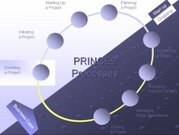Project Management is a seatbelt.
Just like a seatbelt, a good set of Project Management practices and a good plan won't do much if you're caught in a catastrophic situation. For the minor fender-benders and even bigger problems, it will definitely assist, and potentially provide some safety measures and even an escape route or two.
Project Management is a sign of something more.
Going back to the seatbelt analogy, if you put on your seatbelt as soon as you get in the car, I *believe* (no quantitative data to back this up) that you are more likely to be a safer driver. If you habitually perform good project management practices, you will be more likely to detect problems early and have a response plan in place.
Project Management is required.
For any project that involves more than a few hours of effort, some sort of planning is needed. The planning required is directly proportional to the size of the project. If the project consists of writing a new report this afternoon, the "planning" might be 5-10 minutes to think about it. If the project is version of your system, the planning will involve more people and more time. If the project is a $170M system for a major government agency, the planning will involve representatives from numerous meeting repeatedly throughout the lifecycle of the project.
Project Management is about sharing information.
Personally, I don't care if you use a text file sitting out on a shared drive somewhere. There are better tools available, but the point of all of them boils down to making information available to the required people at the required time. It doesn't matter how great your tools are if the decision makers can't get at the information they need.
Project Management is purposeful.
At some point in every project, a decision will have to be made that others are not going to like. In order to have credibility for cutting features, requesting more resources (time, money, people, etc), or pushing back against requirements, the information needs to be available to state unequivicolly "If we do/don't do X, the project is going to suffer in area Y."
Project Management is ongoing.
von Moltke's dictum says that "No battle plan survives first contact with the enemy." Having a project plan a the beginning of the project is a first step, but it's not the last. Regular evaluation, adjustment, and sometimes even retreat is necessary.
I know that last point is a repeat from yesterday, but it bears repeating. Just because you have a pretty Gantt, PERT, or Critical Path diagram on the wall means precisely nothing. As soon as the project begins, there should an evaluation of your Estimates vs your Actuals. Maybe your estimation technique was off, maybe a supporting vendor moved faster/slower than you expected, or maybe a new product is replacing some of the planned work.
If you're not regularly reevaluating the plan, you're not managing... you're coasting.


1 comment:
Wist je dat ik deze blog-post miniteus overgenomen zie bij: http://zbc.nu/ict/project-management/standaard-plan-van-aanpak/
Zelfs de foutjes bij 5.3 en 5.4 zijn hetzelfde....
Post a Comment